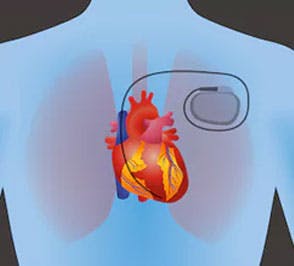Pace Maker Surgery

Pacemaker installation involves inserting a medical device, also called an artificial pacemaker or heart pace maker, to maintain regular heartbeats for patients who experience, or have experienced, heart failure, fainting episodes, or any other such discomforts which might disturb the heart’s natural pacemaker.
A pacemaker uses electrical impulses to regulate the beating of the heart and its primary function is to ensure that an adequate heartbeat rate is maintained at all times. Thanks to modern science, today’s pacemakers are externally programmable, not uncomfortable and even the pacemaker installation surgery procedures are quicker and safer than ever before. The options for pacemaker installation are many and certainly affordable.
Here, you shall find a host of information right from the types of pacemakers, pacemaker installation surgery types and procedures involved in pacemaker insertion to aftercare and recovery time.
What are the Different Types of Heart Pacemakers?
A basic heart pacemaker consists of two main components – leads and pulse generator. Leads, which carry electrical impulses to the heart, are inserted the the veins and heart muscles. The pulse generator, on the other hand, is placed just under your skin and consists of a battery and a minuscule computer. A heart pacemaker is of three types:
Single chamber
This type of pacemaker uses one lead in the upper or lower chambers of the heart.
Dual chamber
These pacemakers use one lead in the upper chambers (atria) and one in the lower chambers (ventricles) of the heart.
Biventricular
A biventricular pacemaker uses three leads – one placed in the right atrium, one in the right ventricle and one in the left ventricle via the coronary sinus vein. Which pacemaker will be recommended by the doctor will depend upon your requirements and medical condition.
What are the Pacemaker Installation Surgery Types?
Pacemaker installation surgery is primarily performed via one of the two approaches – endocardial or epicardial. Local anesthesia is used in the former method, while the latter requires the use of general anesthesia. Let’s throw some more light on these approaches:
Endocardial
Performed under local anesthesia, this pacemaker surgery requires the surgeon to make an incision into the chest to insert the leads as well as the pacemaker. The leads are guided through a vein, and into the heart, with the aid of a fluoroscopy machine. The tip of the leas is attached to the heart muscle. The other end, which is attached to the pulse generator, is placed under the skin in the upper chest.
Epicardial
General anesthesia is used in this type of pacemaker installation surgery. The procedures are more or less similar to the endocardial method, but the recovery time is much longer.
A Brief on Recovery and Aftercare
Thanks to today’s advanced procedures and facilities, pacemaker insertion is a quick surgery, the recovery period isn’t too long and aftercare is very simple. It is very easy to get back to one’s normal routine after pacemaker installation surgery, albeit with a few precautions. Lighter tasks can be resumed a week or 10 days into the surgery, but strenuous activities should be avoided till the doctor gives a green signal. Sports such as golf, swimming, running and tennis should be avoided. Mild bruising, pain and tenderness around the incision site is normal, but much discomfort should be immediately reported.
Post a heart pacemaker surgery, it is important that the patients avoid strong magnetic and electric fields including microwaves, metal detectors, and CT scans. Also, use of electrical devices, such as cell phones, iPods, and appliances must be limited. Regular visits to the specialist for follow ups should not be avoided at any cost. Adjustments, battery check, ensuring that the pacemaker is working fine, and every such detail is taken care of during these follow up visits. A regular schedule of checkups will help your pacemaker last longer.
Pacemaker Insertion Cost abroad vs. the USA
A host of factors, including insurance coverage, pre-existing health, location of the facility and insurance co-pay, influence the cost of pacemaker installation surgery. All these factors, coupled with aftercare charges, sometimes make pacemaker surgery an expensive affair, which cannot be afforded by everyone. This is where pacemaker installation abroad comes as a much welcome approach. In places such as India, Mexico, Jordan, etc., heart pacemaker installation costs much less than it does in the US. It is important to know that low cost does not mean low quality at all. The facilities are world class, the medical procedures are the most advanced and the doctors and surgeons are well trained and much experienced. More and more people are now opting for surgeries in these countries.
DISCLAIMER
This web page provides general information and discussions about health, medicine and related subjects. The information and other content provided on this website, or in any linked materials, are not intended and should not be construed as medical advice, nor is the information a substitute for professional medical expertise or treatment.
The content is for information purpose only and is not a medical advice. Qualified doctors have gathered information from reputable sources; however Credence Medicure Corporation is not responsible for errors or omissions in reporting or explanations. No individual should use the information, resources and tools contained herein to self diagnose or self treat any medical condition.
If you or any other person has a medical concern, you should consult with your health care provider or seek other professional medical treatment. Never disregard professional medical advice or delay in seeking it because of something that have read on this blog or in any linked materials. If you think you may have a medical emergency, call your doctor or emergency services immediately.
The opinions and views expressed on this blog and website have no relation to those of any academic, hospital, health practice or other institution. Credence Medicure Corporation gives no assurance or warranty regarding the accuracy, timeliness or applicability of the content.
